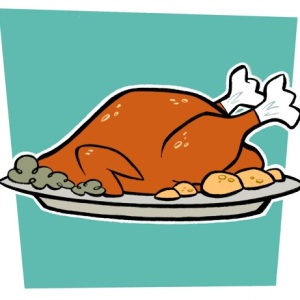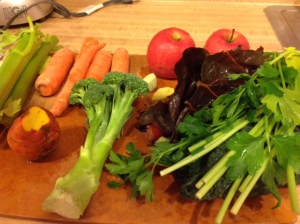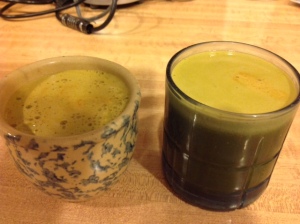“A Sweet Trip”
 Shirley Temple movies seemed to air on TV almost every Saturday during my childhood. So when Shirley Temple Black died this week and her songs were all over the airwaves, I couldn’t get the tunes out of my head. I actually caught myself singing “On the Good Ship Lollipop” one evening while making dinner. Who knew I could remember the lyrics?
Shirley Temple movies seemed to air on TV almost every Saturday during my childhood. So when Shirley Temple Black died this week and her songs were all over the airwaves, I couldn’t get the tunes out of my head. I actually caught myself singing “On the Good Ship Lollipop” one evening while making dinner. Who knew I could remember the lyrics?
And for a nutrition educator, they’re pretty insidious lyrics. They’re all about taking a boat trip to a candy shop to get everything from bon-bons, peppermints, and Cracker Jack to Tootsie Rolls and “a big fat devil’s food cake.” Yow.
I couldn’t remember the final verse, so I looked it up online. And surprisingly, like Bobby Ewing coming back to life, the whole thing was a dream!!
On the good ship
Lollipop
Its a nice trip
Into bed you hop,
And dream away,
On the good ship
Lollipop!
The lyrics turn out to be spot-on: “If you eat too much, ooh, ooh/You’ll awake with a tummy ache.” Go, Shirley!
If you feel like that you’ve become addicted to sugar, you’re not crazy … or alone. Dr. David Ludwig and Dr. Robert Lustig have spent valuable research hours determining that sugar acts like an opiate in the brain. And like drugs, there’s a downward spiral to sugar consumption: once you start overeating it, you just want more and more and more. The best way to break free is to “detox.”
If you’ve had it with your sugar dependency, check out my “Delightful, De-lovely Detox: Break Free from Sugar in 2 Weeks.” It’s one sweet way to get your life — and your waistline — back!
Juicing Jive
I always extol the benefits of juicing – it’s a surefire way to get more vegetables, and it tastes great, too. Note that I said “vegetables” – aside from apples, I don’t juice fruits, because I think most of us get enough fruits in our diets already. But veggies! That’s another story.
This colorful array is a version of what I call “Immune Boost Juice.” It’s loaded with vitamins and minerals, and neatly translates into about 16 ounces of juice. Right now, it consists of 2 apples, an inch of ginger, 2 chard leaves, 2 kale leaves, about 10 springs of parsley, a spear of broccoli, 2 carrots, 1 golden beet and 2 celery ribs. Another version substitutes about 1/2 cup red cabbage for the beets – it’s not as sweet. I drink this juice in the morning, 5 days out of 7, and I am almost never sick. It’s also a great energy boost. Be sure to have it with some healthy fat, like a few nuts, to help your body absorb all the beta-carotene.
And then just wait for your friends and family to tell you that you’re “glowing”! Cheers!
This Year, Wouldn’t You Like to Be “Done with Diets”?
 Has your New Year’s resolution to “lose weight” failed you time and again? Have you tried every fad diet imaginable and still haven’t lost weight … or have you lost pounds, then gained them all back? Do you try to “eat healthy” but still have trouble shedding extra pounds? Is it possible to eat and be satisfied and still lose weight?
Has your New Year’s resolution to “lose weight” failed you time and again? Have you tried every fad diet imaginable and still haven’t lost weight … or have you lost pounds, then gained them all back? Do you try to “eat healthy” but still have trouble shedding extra pounds? Is it possible to eat and be satisfied and still lose weight?
The word “diet” really just means “a way of life.” It doesn’t mean — as many of us have come to believe — “a painful time of depriving yourself in order to lose weight … so that you can then return to your old eating habits, and start all over again!”
For my Pittsburgh readers, on January 29, I will be teaching the basics of losing weight naturally and keeping it off at the “Done with Diets!” workshop. Tips, recipes, menu ideas and a healthy snack are included.
This workshop is for you if you:
* Are sick and tired of being “on a diet”
* Have tried more than one of the hundreds of “diets” out there (and have the bookshelf to prove it)
* Have hit a weight-loss plateau
* Keep clothes in different sizes, because your weight yo-yos
* Love to eat, but hate the taste of cardboard “diet foods”
* Do better losing weight when you have support from others
* Worry that weight gain will lead to health problems down the road … if it hasn’t already
If alarms went off as you read that list, you can be “Done with Diets!” in 2014! Here are the deets:
Done with Diets!
Wednesday, January 29, 2014, 6:00 to 7:30 p.m.
The Nuin Center, 5655 Bryant Street, Pittsburgh, PA 15206
Cost: $25/person
Register online — sign up with a friend and you’ll each save $5!
Hurry! Registration is limited, so please sign up by January 25.
And better yet: after the workshop, you’ll have the opportunity to join a “Done with Diets!” peer support group and check-in, offered monthly for a low fee. Being part of a group of folks with similar goals will help you stay motivated and stick to your guns. Details will be provided at the workshop.
I hope to see you soon — in the meantime, have a joyous, healthy new year!
Be SMART in 2014
If you’re sitting down to write your New Year’s Resolutions, take a moment to plan how to make your goals more achievable in 2014. Make those resolutions SMART ones this time around!
SMART resolutions are ones you can actually, conceivably keep. The template goes like this:
Specific
Measurable
Attainable
Realistic
Timely
The way many of us have learned to write goals is way too vague – that’s a big reason we never really achieve them. We set ourselves up for letting our fuzzy goals slip out of view.
For example, writing “Lose weight” as a goal doesn’t give you a SMART way to make that resolution a reality. However, writing “Lose 1 pound a month” gives you a specific, measurable, attainable, realistic and timely goal to aim for. It also means that, when you hit your mark next December, you will have shed 12 pounds.
“Eat at home more” is easily dismissed as a goal. But “Cook dinner at home 4 nights a week” isn’t.
Similarly, writing “Exercise more” doesn’t hold you accountable to your goal. But writing “Walk briskly for 30 minutes 3 times a week” or “Bike to work and back twice a week” gives you a concrete plan of action.
After you write your resolution, create a list of strategies for attaining the goal. For example, if your goal is to “Walk briskly for 30 minutes 3 times a week,” your strategies might include asking a friend or partner to go with you, getting some walking music to play on your phone or downloading a step-tracking app that will make you proud of your progress.
A strategy to support your specific weight-loss goal might be to take a workshop, like my “Done with Diets!” workshop offered later this month in Pittsburgh.
How can you quantify your resolutions so you set yourself up for success?
Nutrition U: 2013 in review
The WordPress.com stats helper monkeys prepared a 2013 annual report for this blog. Happy New Year, one and all!
Here’s an excerpt:
A New York City subway train holds 1,200 people. This blog was viewed about 4,900 times in 2013. If it were a NYC subway train, it would take about 4 trips to carry that many people.
10 Tips for Surviving Thanksgiving Dinner
 Just because it’s Thanksgiving doesn’t mean you have to gobble everything in sight. Try a few simple techniques for maintaining a healthy relationship to food, even on holidays.
Just because it’s Thanksgiving doesn’t mean you have to gobble everything in sight. Try a few simple techniques for maintaining a healthy relationship to food, even on holidays.
1. Drink a glass of water before dinner or a party. This helps cut back on hunger.
2. Don’t skip a meal before eating dinner, in preparation for “The Big Meal.” Eat a normal breakfast and lunch, so you’re less likely to be famished for dinner and more likely to stick with healthful amounts.
3. Use a smaller plate, and put your fork down between bites.
4. If the holiday dinner is family style, enjoy a serving of what’s on the table, then remove your plate to also remove the temptation for seconds … or thirds.
5. If there is a buffet or hors d’oeuvre table, bring your own healthy dish to share. Have a small plate of healthy stuff – fruits, crudités, goat cheese. Pass on breads, chips and other addictive, salty/sweet calories. Go for dips like hummus or tapenade.
6. Recall happy holiday food memories while knowing you don’t have to repeat experiences of overindulging or overeating because you attach a pleasant memory to holiday meals. Tell a story at the dinner table instead of reliving the experience of overindulgence.
7. Decide in advance what your sweet indulgence will be and stick with it. For example: “I love pumpkin pie, so I’m going to have a slice” – instead of being faced with a smorgasbord of pie, cake, brownies, cookies, etc., and then bingeing on all of them. Enjoy a smaller slice that will still satisfy your desire for the taste.
8. Alcoholic drinks are empty calories. Limit yourself to a glass so that you can choose another indulgence instead.
9. Lead by example. Families and friends sometimes overindulge at holidays because “everyone’s doing it” or “what the heck, it’s Thanksgiving!” Show your loved ones that you’re serious about healthful eating by limiting your amounts and sticking to your guns. They may then be less likely to try to cajole you into unhealthy overindulgence – and may even cut back themselves.
10. Give food away. If you’re the host and find yourself left with too many sweets or other foods, have takeaway bags or containers handy so that you can portion them out to guests. If your guests decline the doggie bags, share leftover food with a local shelter. If you’re visiting relatives or friends, opt to take home turkey instead of cookies or pie.
Sugars R Not Us
 As a nutritionist, this didn’t surprise me, but I still loved hearing a Harvard scientist expound on it: Human bodies were not designed for the amount of sugar and processed foods we dump into them. Hence, many illnesses – from the big diseases like type 2 diabetes and heart disease to lesser ailments like acid reflux – have become epidemic in our society.
As a nutritionist, this didn’t surprise me, but I still loved hearing a Harvard scientist expound on it: Human bodies were not designed for the amount of sugar and processed foods we dump into them. Hence, many illnesses – from the big diseases like type 2 diabetes and heart disease to lesser ailments like acid reflux – have become epidemic in our society.
Dr. Daniel Lieberman is an evolutionary biologist whose new book, The Story of the Human Body: Evolution, Health and Disease, was featured on NPR’s “Fresh Air” with Terry Gross the other day. Give the show a listen or a read; it’s well worth your time!
Where’s the Nutrition?
Here’s a nifty infographic that looks at the phytonutrients in food — those miraculous plant chemicals that protect plants while they’re growing, and in turn benefit human health. Get the most nutrition out of your food by eating a rainbow of deep, rich colors. Most of all, enjoy!

An infographic by the team at Online Masters In Public Health
The Weight-Loss Buck Stops Here
 I’ve been doing a freelance editorial project in which I have to look at health and nutrition topics that people search for online. The vast majority of the searches are about the benefits of specific diets, including obscure ones I’ve never heard of, and methods for losing weight in specific areas of the body, like the belly or thighs.
I’ve been doing a freelance editorial project in which I have to look at health and nutrition topics that people search for online. The vast majority of the searches are about the benefits of specific diets, including obscure ones I’ve never heard of, and methods for losing weight in specific areas of the body, like the belly or thighs.
This project is starting to make me sad. I find I’m going very slowly on it, because it’s discouraging to see how many people look for quick fixes to their weight issues – diet pills, self-hypnosis, lemon cleanses, a single food to “zap” the metabolism, a way to lose a scary amount of weight in a week or a month. I will probably never meet any of these online searchers face-to-face, yet I find myself wanting to sit down with them and talk to them about switching to a healthful diet for the long term, which would help them shed pounds. Not quickly, it’s true, but safely – and for good.
A nutritionist’s job can be difficult. So much rides on my clients’ willingness to change – will they really cut out soda, or will they come back next month and say they just couldn’t do it? Even the person who seems to motivated in our initial meeting may return for a follow-up appointment and admit she just didn’t do anything because she says she lacks “willpower.” Or worse, she may not return at all, opting instead for hypnosis or a dangerous diet.
Nutritionists can guide you and steer you, offer helpful advice and even outline healthful eating plans. They can suggest supplements that might benefit you and herbs that could support your goals. They can give you lots of pep talks, supply research on various foods and be a kind of “cheerleader,” as one client called me recently. That’s all good, and I love those parts of my job.
But ultimately, the buck stops with you. You need to show up, to actually follow through, to makes changes. If you fall off the dietary wagon one day, you get right back on. As a friend of mine puts it, “You can start your day over at any time.”
This is not passive work, but you will see change. And you will keep you moving toward your goal of a healthy weight – and a healthy life.
“Killer” Recipes
 It can be hard to be a nutritionist on Facebook.
It can be hard to be a nutritionist on Facebook.
I don’t mean on my business page (be sure to “like” it!). I mean when I’m casually skimming the feed on my personal site, where I’m not “Paula Martinac, MS.”
There, I’m just a bunch of people’s “friend.” There, I feel like I have to hold my tongue when people post and re-post recipes that are health disasters in the making. After all, no one asked me to rain on his or her parade. And that’s how it might be perceived if I went on a tirade about dishes that are just convenient delivery systems for salt, sugar and fat – the triumvirate of food addictions in the standard American diet (appropriately shortened to “SAD” by nutritionists).
I didn’t make this stuff up. Eating the SAD diet has real consequences. Ask any of my clients who eventually find their way to me to learn how to eat healthfully after years of fast food, soda pop, pizza and chips. Many of them are on multiple medications and are just starting to feel the toll that prescription drugs for hypertension, heart disease and type 2 diabetes can take on a person’s body.
Ask Big Food executives if they actually eat the stuff their companies produce. According to Michael Moss in his eye-opening book Salt, Sugar, Fat, with processed foods, “the inventors and company executives don’t generally partake in their creations.”
Here’s a fact I’ve stressed before, but I’m going to bore you with it again: high blood pressure, heart disease and type 2 diabetes are “lifestyle diseases.” That means a change in your lifestyle – i.e., diet and exercise – can put you on the road to reversing these conditions and dropping the meds. More than 80 percent of all instances of high blood pressure, for example, can be brought under control with lifestyle changes.
One client in her late 30s recently said that she imagined herself on multiple medications at, say, 50 or 60, but never at her age. When I pointed out that I’m in that higher age bracket and take no medications whatsoever, she fell silent.
Well, enough of my rant … for now. If this post can coax one Facebook-er to stop pushing “killer” recipes like heroin, I’ll be a happy camper. And if I can get one more person to start taking steps toward a healthier life, I’ll be absolutely ecstatic.





